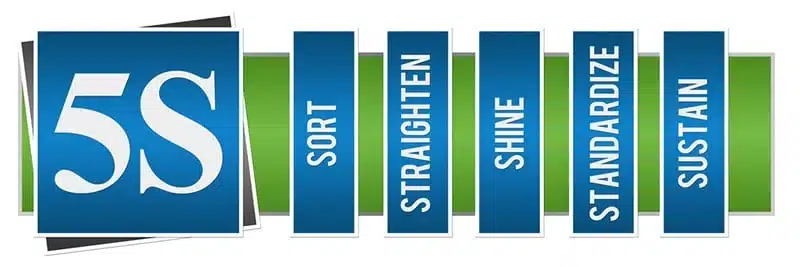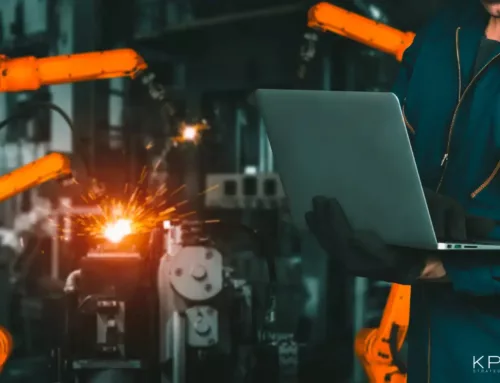Imagine a workspace where everything has its place, tools are readily available, and clutter is nonexistent. This isn’t just a dream; it’s the reality achieved through the 5S system. In today’s fast-paced, efficiency-driven world, businesses across industries are constantly seeking ways to optimize operations and reduce waste. The 5S system, a lean manufacturing tool, offers a structured approach to workplace organization and standardization. This article provides a comprehensive overview of the 5S system, explaining its principles, implementation, and benefits, making it an essential guide for anyone looking to improve their work environment, from manufacturing professionals to office administrators.
Main Takeaways From This Article:
- 5S: A Blueprint for Streamlined Work: Forget mere tidiness; this system is a deliberate strategy to engineer a workspace where efficiency reigns. It’s about crafting a flow that minimizes wasted effort and maximizes safety.
- Built on Lean Foundations and the Spirit of Gradual Progress: Born from Toyota’s manufacturing innovation, 5S is fueled by the ‘Kaizen’ mindset, where small, consistent improvements forge significant long-term gains.
- The Five Pillars of 5S: A Sequential Transformation: The journey involves a structured progression: decluttering, organizing, sanitizing, standardizing, and embedding these practices into the daily routine.
- Tangible Results: Beyond a Clean Sweep: The payoff isn’t just a tidy space. It’s a boost in productivity, clearer visual cues for smoother operations, a more engaged team, a safer environment, and smarter use of resources, all leading to cost reductions.
- The Long Game: Tools and Vigilance for Lasting Impact: To avoid a temporary fix, continuous monitoring and the right tools are crucial. Transitioning from a one-off project to a sustained culture requires active management and data-driven adjustments.
What is the 5S System?
5S is a structured approach to workplace organization that allows teams to work efficiently, effectively, and safely by focusing on putting everything where it belongs and keeping the workplace clean, making it easier for people to do their jobs without wasting time or risking injury.
It’s often overlooked that improving the small things around you can greatly impact the large aspects of your work process. A well-implemented 5S system can help you make your workplace a sanctuary of productivity, but it’s not just about cleanliness. It’s a systemized process for optimizing workflows that will allow your team to work with more discipline and apply every tool in the Lean arsenal with less effort.
The Origins of the 5S System
In the history of business improvement methodologies, the 5S system was born from the crucible of Lean manufacturing and the relentless pursuit of continuous improvement. The 5S system provides a structured framework for workplace optimization – and its impact extends far beyond simple housekeeping, laying the groundwork for operational excellence.
The Concept of Kaizen (Continuous Improvement)
What is Kaizen? It’s the Japanese philosophy of continuous improvement, is deeply intertwined with the 5S system, providing the underlying mindset for sustained progress. Kaizen emphasizes small, incremental changes made consistently over time, fostering a culture where every team member actively seeks opportunities for optimization. This approach ensures that 5S is not a one-time event, but an evolving process that leads to ongoing enhancements in efficiency and quality.
The Role of the Toyota Production System
Toyota developed 5S as an integral component of its Toyota Production System (TPS), a revolutionary approach to Lean manufacturing. TPS aimed to eliminate all forms of waste, or “muda,” and 5S provided a structured method for achieving this by optimizing the workspace and streamlining processes. By systematically organizing and cleaning work areas, Toyota reduced wasted motion, minimized errors, and improved overall efficiency, demonstrating the power of 5S in achieving Lean automobile manufacturing goals.
5S as a Foundation in the Lean Manufacturing Industry
5S as a Foundation in the Lean Manufacturing Industry: Within the Lean manufacturing paradigm, 5S emerged as a foundational element, establishing a pragmatic structure for achieving amplified efficiency, heightened quality, and unwavering standardization. By fostering a meticulously ordered and standardized workspace, 5S inherently curtails waste, mitigates errors, and elevates the overall flow of operations, cementing its status as an essential instrument for enterprises dedicated to Lean methodologies.
Global Adoption of 5S
The inherent logic of 5S has propelled its adoption far beyond the factory floor, permeating sectors as varied as healthcare, logistics, and retail. Its core focus on meticulous organization, streamlined efficiency, and consistent standardization renders it a universally valuable methodology, adaptable to any operational setting. This widespread implementation serves as a testament to 5S’s fundamental capacity to cultivate operational excellence success across diverse domains.
Overview of 5S Implementation
| Japanese | Translated | English | Definition |
| Seiri | organize | Sort | Eliminate whatever is not needed by separating needed tools, parts, and instructions from unneeded materials. |
| Seiton | orderliness | Set in order | Organize whatever remains by neatly arranging and identifying parts and tools for ease of use. |
| Seiso | cleanliness | Shine | Clean the work area by conducting a cleanup campaign. |
| Seiketsu | standardize | Standardize | Schedule regular cleaning and maintenance by conducting seiri, seiton, and seiso daily. |
| Shitsuke | discipline | Sustain | Make 5S a way of life by forming the habit of always following the first four S’s. |
1. Sort
The first step of 5S, Sort, involves going through all the tools, furniture, materials, equipment, etc. in a work area to determine what needs to be present and what can be removed. Some questions to ask during this phase include:
- What is the purpose of this item?
- When was this item last used?
- How frequently is it used?
- Who uses it?
- Does it really need to be here?
These questions help determine the value of each item. A workspace might be better off without unnecessary items or items used infrequently. These things can get in the way or take up space.
Keep in mind the best people to assess the items in a space are the people who work in that space. They are the ones who can answer the above questions.
2. Set in Order
Once the extra clutter is gone, it’s easier to see what’s what. Now work groups can come up with their own strategies for sorting through the remaining items. Things to consider:
- Which people (or workstations) use which items?
- When are items used?
- Which items are used most frequently?
- Should items be grouped by type?
- Where would it be most logical to place items?
- Would some placements be more ergonomic for workers than others?
- Would some placements cut down on unnecessary motion?
- Are more storage containers necessary to keep things organized?
During this phase, everyone should determine what arrangements are most logical. That will require thinking through tasks, the frequency of those tasks, the paths people take through the space, etc.
3. Shine
Everyone thinks they know what housekeeping is, but it’s one of the easiest things to overlook, especially when work gets busy. The Shine stage of 5S focuses on cleaning up the work area, which means sweeping, mopping, dusting, wiping down surfaces, putting tools and materials away, etc.
In addition to basic cleaning, Shine also involves performing regular maintenance on equipment and machinery. Planning for maintenance ahead of time means businesses can catch problems and prevent breakdowns. That means less wasted time and no loss of profits related to work stoppages.
Shining the workplace might not sound exciting, but it’s important. And it shouldn’t just be left up to the janitorial staff. In 5S, everyone takes responsibility for cleaning up their workspace, ideally on a daily basis. This way, people take ownership of the space, which in the long run means people will be more invested in their work and in the company.
How to clean may seem obvious, but make sure people know how to properly Shine their spaces. Show employees—especially new employees—which cleaners to use, where cleaning materials are stored, and how to clean equipment, particularly if it’s equipment that could be easily damaged.
4. Standardize
Once the first three steps of 5S are completed, things should look pretty good. All the extra stuff is gone, everything is organized, spaces are cleaned, and equipment is in good working order.
The problem is, when 5S is new at a company, it’s easy to clean and get organized, and then slowly let things slide back to the way they were. Standardize makes 5S different from the typical spring-cleaning project. Standardize systematizes everything that just happened and turns one-time efforts into habits. Standardize assigns regular tasks, creates schedules, and posts instructions so these activities become routines. It makes standard operating procedures for 5S so that orderliness doesn’t fall by the wayside.
Depending on the workspace, a daily 5S checklist or a chart might be useful. A posted schedule indicating how frequently certain cleaning tasks must occur and who is responsible for them is another helpful tool.
Initially, people will probably need reminders about 5S. Small amounts of time may need to be set aside daily for 5S tasks. But over time, tasks will become routine and 5S organizing and cleaning will become a part of regular work.
5. Sustain
Once standard procedures for 5S are in place, businesses must perform the ongoing work of maintaining those procedures and updating them as necessary. Sustain refers to the process of keeping 5S running smoothly, but also of keeping everyone in the organization involved.
Managers need to participate, as do employees out on the manufacturing floor, in the warehouse, or in the office. Sustain is about making 5S a long-term program, not just an event or short-term project. Ideally, 5S becomes a part of an organization’s culture. And when 5S is sustained over time, that’s when businesses will start to notice continuous positive results.
To help sustain 5S practices, make sure all new employees (or employees who switch departments) receive training about their area’s 5S procedures.
5S Requires You to Sweat the Right Small Stuff
Excellence in all areas of your business can flow from determining the right small details to focus on. For example, in the world of sports, the New Zealand All-Blacks rugby team, one of the most successful teams in history, has the habit of cleaning the dressing room after every match- win or lose. Every player, including the stars, is expected to pick up, sweep up, and generally leave the dressing room as good or better than they found it.
Perhaps this is a little thing, but it says much about the character and culture of the team, doesn’t it? It shows discipline, and it highlights the power of the small things. If you knew just this one thing about this team, and you had to bet, would you bet they were successful or average?
Benefits of the 5S Methodology
The 5S methodology delivers tangible, measurable benefits across diverse industries, acting as a catalyst for enhanced efficiency, heightened safety, and significant waste reduction. Its systematic approach translates into concrete improvements that impact the bottom line and overall operational effectiveness.
Enhances Workplace Efficiency by Eliminating Waste
Adapting 5S in the workplace helps reduce the 8 wastes, including unnecessary motion, wasted time, and inefficiencies in workflows. By eliminating unnecessary items and organizing the workspace, 5S minimizes wasted time and motion. This streamlined environment allows employees to locate tools and materials quickly, leading to increased productivity and reduced cycle times.
Improves Workplace Organization with Visual Management
“Sort” removes unnecessary items, and “Set in Order” assigns designated locations, making it immediately apparent when something is missing or out of place. This visual clarity enhances situational awareness and promotes immediate corrective action. Shadow boards and floor markings, a direct result of “Set in Order,” provide clear visual cues for tool and material placement. This eliminates searching and reduces wasted time, leading to a more streamlined workflow.
Drives Continuous Improvement and Employee Engagement
The visible results of 5S, such as a clean and organized workspace, create a sense of accomplishment and pride among employees. This increased morale and engagement translates to a more proactive and involved workforce.
Strengthens Workplace Safety and Hazard Prevention
5S reduces potential hazards, workplace injuries, and spills by ensuring a clean and structured workspace. In particular, “Sort” eliminates unnecessary clutter and potential tripping hazards, reducing the risk of workplace accidents. This proactive approach to hazard identification minimizes potential dangers.
Optimizes Space and Reduces Excess Inventory Costs
This optimization of space translates to lower storage costs and improved workflow. “Set in Order” ensures that only necessary items are kept in the workspace, preventing the accumulation of excess inventory. This streamlined approach to inventory management minimizes waste and reduces associated costs.
The Costs of 5S vs. Long-Term Savings
Leaders and managers evaluating 5S might initially perceive it as an expense. However, it’s more accurately viewed as a strategic investment that yields significant returns. While there may be an initial outlay for essential tools like floor marking tape and labels, and a commitment to employee training and 5S implementation, these are investments that pay dividends. By streamlining processes and proactively mitigating potential errors, 5S ultimately enhances operational efficiency and reduces costly disruptions. The long-term benefits of 5S, including improved productivity and reduced waste, translate directly into substantial cost savings, making it a valuable investment rather than a mere expense.
How to Use KPI Fire to Sustain and Optimize 5S
The initial burst of implementing 5S often fades without a robust system for continuous monitoring and accountability. KPI Fire bridges this gap, transforming 5S from a one-time event into a dynamic, sustainable process that aligns with overarching business objectives. It provides the tools necessary to maintain momentum and drive ongoing optimization.
- Monitor 5S Compliance in Real Time: KPI Fire’s digital audit capabilities provide a live, visual representation of 5S adherence, allowing for immediate identification of discrepancies and enabling proactive interventions rather than reactive responses.
- Set and Align 5S Goals with Business Objectives: By integrating 5S metrics into the broader framework of organizational KPIs, KPI Fire ensures that 5S initiatives are not isolated activities, but rather integral components of achieving strategic business outcomes.
- Automate Accountability and Workflow Execution: KPI Fire automates the assignment, tracking, and escalation of 5S-related tasks, eliminating the reliance on manual processes and ensuring consistent follow-through on audits and corrective actions.
- Use Data-Driven Insights for Continuous Improvement: KPI Fire’s analytical dashboards transform raw 5S data into actionable insights, revealing patterns and trends that empower teams to identify optimization opportunities and implement targeted improvements.
Make 5S a Lasting Success with KPI Fire
The 5S system, far from a mere housekeeping initiative, is a strategic lever for driving tangible operational gains. By instilling a culture of meticulous organization, it directly eliminates hidden wastes and cultivates an environment where efficiency thrives. This translates to measurable improvements in productivity, safety, and cost-effectiveness, transforming daily workflows into streamlined processes that fuel continuous improvement.
However, the challenge lies in sustaining these gains beyond the initial implementation. That’s where KPI Fire steps in, bridging the gap between strategic intent and consistent execution. Its real-time tracking, automated workflows, and visual dashboards transform 5S from a static project into a dynamic, data-driven initiative. By providing clear visibility into compliance and performance, KPI Fire empowers teams to proactively address deviations and optimize processes, ensuring 5S remains a living, evolving part of the organization’s culture.
Don’t let your 5S efforts plateau. Request a demo today to see firsthand how KPI Fire can unlock the full potential of your 5S program and drive lasting operational excellence.
5S System FAQs
What are the 5S of Kaizen?
The 5S framework, a core component of the Kaizen philosophy, guides workspace refinement through a series of actions. It begins with the act of Seiri, where unnecessary items are removed, followed by Seiton, which establishes an orderly arrangement for remaining tools and materials. Then, Seiso emphasizes the importance of thorough cleaning, and Seiketsu instills standardized procedures to maintain that cleanliness and order. Finally, Shitsuke ensures these practices become ingrained habits, fostering continuous improvement.
How does 5S fit into Lean manufacturing?
Within the Lean manufacturing paradigm, 5S serves as a fundamental building block. It directly contributes to the elimination of waste by creating an environment where resources are readily accessible and processes flow smoothly. Through meticulous organization and standardization, 5S minimizes wasted motion, reduces errors, and optimizes the overall efficiency of operations, laying a critical foundation for other lean tools to operate effectively.
What are the 5S Japanese words?
The 5S methodology originates from Japan, and its core principles are represented by the following Japanese terms: Seiri, which signifies sorting; Seiton, which denotes setting in order; Seiso, which means shining or cleaning; Seiketsu, which refers to standardizing; and Shitsuke, which translates to sustaining.
How do you sustain 5S after implementation?
Maintaining the gains achieved through 5S requires a sustained commitment to ongoing effort. This involves conducting regular audits to ensure adherence to established standards, providing consistent training to reinforce best practices, and implementing clear visual management tools to promote awareness. Furthermore, integrating 5S practices into daily routines and utilizing data-driven insights for continuous improvement are essential for cultivating a culture of lasting order and efficiency.
How long does it take to implement 5S?
The timeline for 5S implementation is variable, depending on the scope of the workspace and the organizations dedication. Initial implementation phases can take weeks, or months to accomplish. However, the true realization of 5S occurs when it becomes deeply embedded within the organization’s culture, this process of cultural change can take years. Therefore, 5S is best viewed as a continuous journey of improvement, rather than a discrete project with a fixed endpoint.





